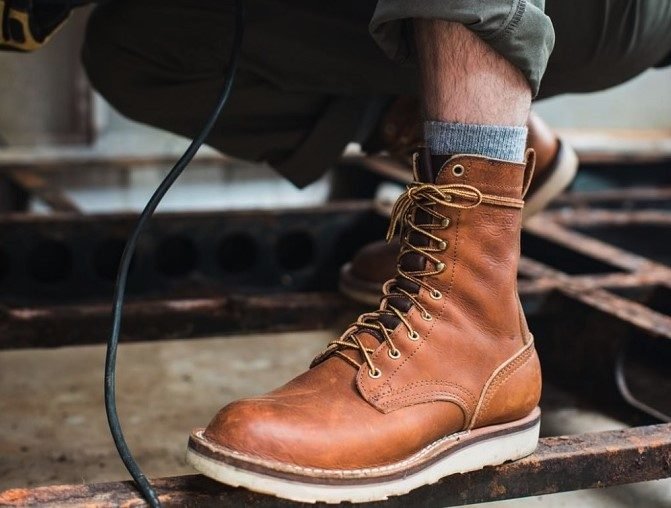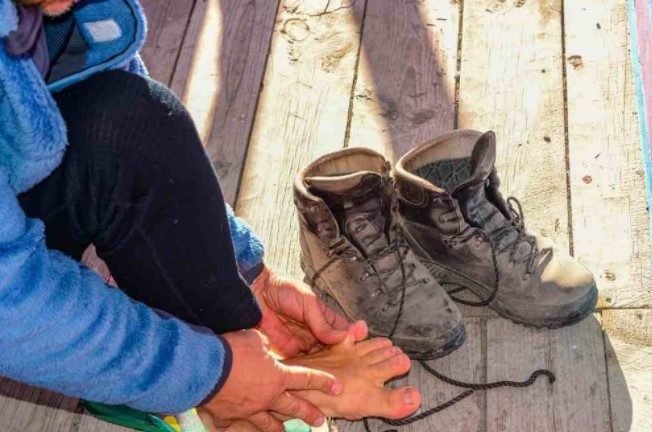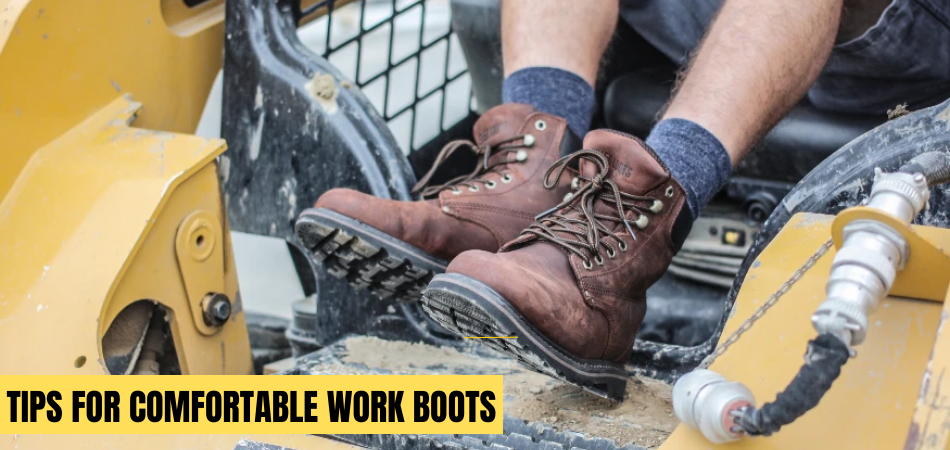One of the toughest and most protective footwear to own as a worker is the work boots. These tough-skinned shoes usually come in high soles and leather skins. However, work boots are not the most comfortable to work in. These boots are the most rigid for the toes and bulky to walk in comfortably.
So, how do I stop my feet from hurting in work boots? You should massage your hurting feet, rest them often, go for larger-sized boots, use tongue pads, thick socks, and shoe inserts. These, among others, are a few solutions you can try to remedy your feet from hurting in your work boots.
Why are they necessary, and what benefits do they provide your feet? We have provided all the sufficient answers for you in this article. Keep reading!
Contents
Is It Bad To Wear Work Boots Every Day?
Wearing boots every day is not bad, so long as the boots are the right pair. That said, wearing ergonomically proper work boots for your feet will not be harmful even after putting them on for a prolonged time.
Work boots that provide sufficient foot support in all places and also allow flexibility for your feet are the best options you should get. However, there are a few things that you should consider before going for any work boot, and let’s look at them below.

Shock absorption in your work boots
The essential part of your feet is your heel, and the right work boots should provide sufficient material to cushion them. Work boots are usually ideal for heavy-duty tasks. They require dense materials that are tough enough to absorb shocks and also versatile enough to allow you to flex your feet.

Great quality work boots usually comprise hard rubber heel blocks or several risers that are produced from vegetable-tanned leather materials. The heel receives the most impact while walking; it strikes as the foot rolls forward. Also, the foot’s ball doesn’t receive much impact and then moves over to the next stride.
The function of a great work boot is to minimize the amount of shock the heel receives. This requires sturdy construction and good-quality materials. On the flip side, poor-quality boots are mostly more affordable but do less shock absorption and, therefore, punish your feet. Poor-quality work boots give you foot fatigue and other serious impact injuries in the long run.
Support Arch and work boots
The arch of your feet is another essential area to consider while deliberating on work boots to purchase. It acts as a mechanical suspension while walking as it compresses and stretches for you to move with your feet’s ball properly—thus, springing.

Feet that have ideal/neutral arches allow you to land plain flat while walking. But, there are only a few people that have a neutral arch. Most individuals worldwide have either a bit too low or too high.
A foot with a high arch will rotate slightly outward (under-pronation or supination). In contrast, a foot with two low arches will rotate slightly inward. Over time, under-pronation can cause several problems, including plantar fasciitis (or policeman’s heel), knee, back, lower leg, and hip problems.
Thus, some individuals go for “barefoot” type of shoes to balance their footwear and feet. However, this is not an ideal choice for individuals who walk about and do many standing in their daily works. For a remedy, these people use insoles in their work boots to support their arches.
Working boots that don’t provide sufficient arch support or materials within the arch limit your feet and can easily cause feet fatigue. This can also eventually cause leg-related injuries.
Comfort
The third primary thing to consider while choosing a work boot is comfort, as poor-quality work boots provide low-quality footbeds. This footbed is the material that lies between the sole of your foot and the insole within your boots.

Usually, good-quality work boots come with tough footbeds that are initially uncomfortable and hard. This is so because the footbed needs to take some time to be beaten to shape by your feet. The footbed needs to break into the shape of your feet repeatedly until it can cushion your foot impacts without giving you discomfort. Manually creating your own footbed requires several layers of long-lasting materials, such as a vegetable-tanned footbed, rather than the regular cork footbed.
Most company work boots come with cork footbeds, which aren’t durable, thus damage quickly. The foam in the cork footbed eventually erodes until it flattens out, and your feet will ache while wearing the work boots.
A good work boot should come with a solid and tough footbed that can slowly form with your foot’s shape and provide enough support. You notice poor footbed support from cheaper work boots because the manufacturers consider the cost of quality. So, buying such shoes is unhelpful in the long run.
Why Do My Feet Hurt In Work Boots?
Basically, the feet are prone to hurting in work boots if they don’t receive sufficient support. That stated, let’s consider a few causes of hurting feet in work boots.

- Insufficient Arch Support: Majorly, the lack of arch support causes the feet to hurt easily. We have already explained above the essence of proper arch support and the adverse effects of having a poor quality arch support.
- Incompatible Workboots: Wearing a smaller-sized or incompatible work boot will cause feet aches. This is because it will be difficult for your feet to balance with the internal structure of the work boots.
- The degree of work: Another cause of aching feet in work boots is the amount of activity you put on them. If you put your feet under excess pressure for a prolonged time and in uncomfortable situations, they will ache. It is true that the more physical labor you exert on your work boots, the more the chances of experiencing challenges with your feet in your work boots.
How Do I Stop My Feet From Hurting In Work Boots?
How do I stop my feet from hurting in work boots? There are several remedies to stop aching feet in your work boots. They include using tongue pads, lacing your boots rightly, opening holes into your toe regions, using bandages, and rubbing Vaseline, etc. Let’s look at them in full detail below.

Bore Holes in the Toe Regions of Your Boots
A very helpful trick to solving aching feet problems in your boots is to cut holes in the toe regions of your boots. To do this, take out the insole from your boot, then cut the toe region open. After that, put back the insole to the boots. Also, note that while this method is helpful in relieving your feet from aches and pains, it also risks your toes from getting directly affected by an impact.
Put On Thick Socks
Thick socks are a great solution for layering your feet’ base. Wearing a sock generally absorbs the pressure dispersed on it by your feet and reduces heel pressure. Also, thick socks provide soothing layers for your heels and reduce frictions in the boots.
Use Tongue Pads
When you pad your boots, it provides additional comfort for your feet. In addition, tongue pads help a lot for compressed or sharp toe walls and edges. Using the tongue pad is one of the most effective ways to provide comfort for your feet in a tight and uncomfortable boot.
Lace Your Boots Properly
Another useful solution for hurting feet in work boots is lacing your boots properly. This is because when you lace your boots, it keeps your feet well-placed in the boots. However, some boots are without lace and therefore make your toes ache.
So, if you’re shopping for a work boot pair, ensure to choose the multiple-laced ones or get a customized one.
Have Multiple Work Boots
We all know that consistently using a thing for a while will cause it to deteriorate, eventually. For a remedy, you can have two or three other work boots to work with and vary in use. In addition, you can vary the time you wear these work boots daily each week. This will prolong the efficiency and lifespan of your boots.
Rub Vaseline
Vaseline has a thick coating that protects the skin from blisters. If you apply Vaseline to your feet, your feet will stand a better chance against calluses and blisters. Ensure to apply a reasonable amount of petroleum jelly or vaseline to any aching area in your feet.
Select the Right Boots
We can’t understate the usefulness of going for the right boot. First, make sure the size you use fits snugly to your feet. It mustn’t be too tight nor too loose. This is because large work boots will allow your leg to move too freely within them and can be bulky, whereas smaller boots are tighter and more uncomfortable.
One major thing to understand is that boots with very pointy fronts are the most hurtful ones. So, go for those that tally with your toe shape, as they are the most comfortable ones. Additionally, ensure to find out the Best Breathable Work Boots for your feet, pocket, and nature of work.
Wear Band-Aids around Your Toes
Usually, the most hurt toes while wearing work boots are the two at the extreme, the first and last toes. If they hurt you while wearing your work boots, take off the boots and wrap some bandages around them.
Go for a Pair with Arch Support
Last, arch support is one major thing factor to consider while going for work boots. This is essential, so ensure that the boot you purchase has good-enough arch support. Alternatively, if you already have a boot without arch support, then go for insoles.
Conclusion
How do I stop my feet from hurting in work boots? First, ensure to get the right pair of boots, then thick socks and insoles if need be. These are just among a few other remedies for preventing or eradicating hurting feet in your work boots.
Ensure to put these in mind while going for work boots so that you don’t end up regretting the boots you purchase. Also, always get the right size as the wrong one will hurt your feet.

